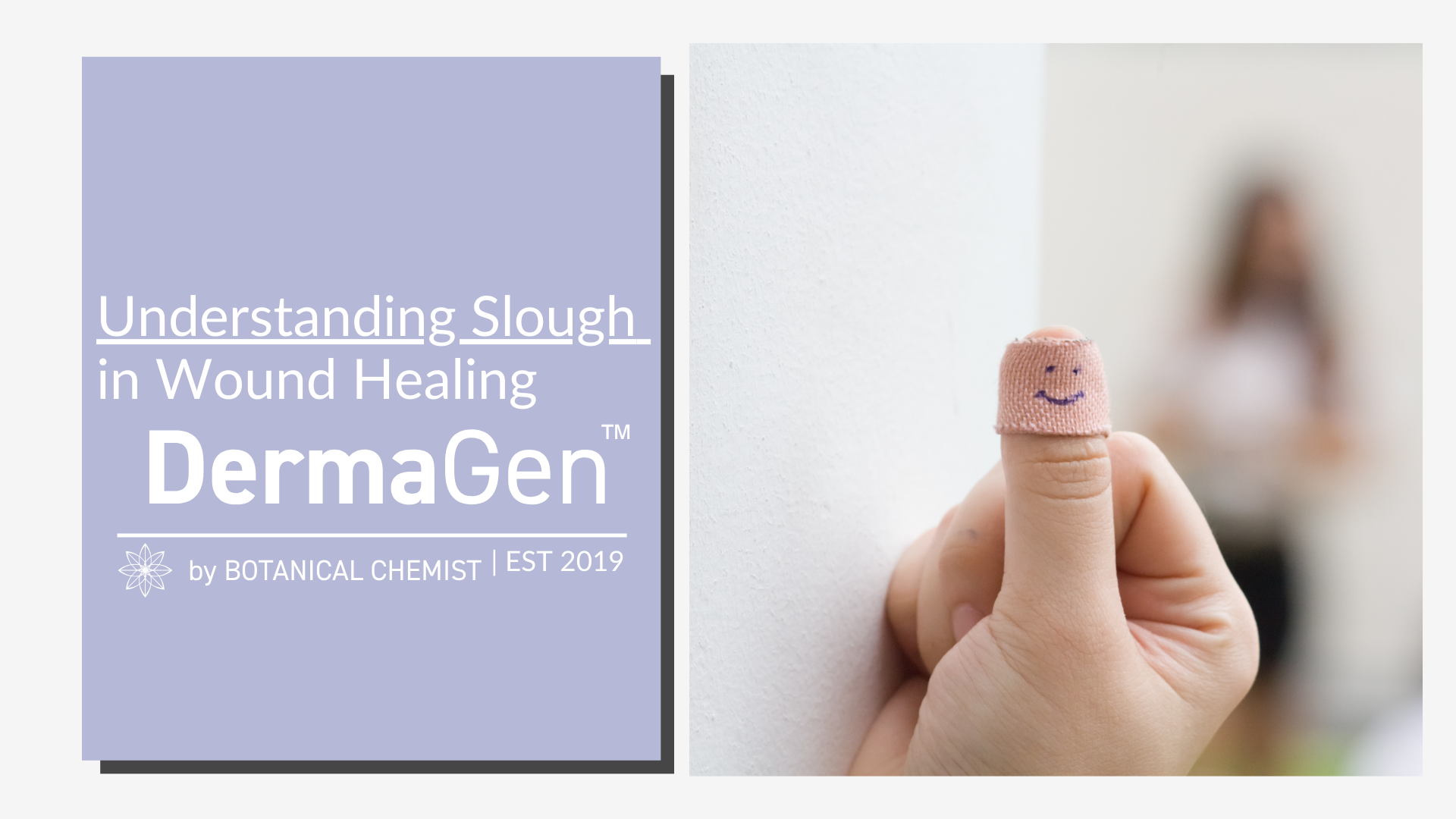Slough is a common and natural occurrence in the wound healing process, particularly in wounds that are healing by secondary intention.
This process involves the wound healing from the bottom up and from the edges inward when the wound edges cannot be brought together.
Understanding the components of slough can provide insights into the state of wound healing and guide appropriate care strategies.
Components of Slough:
Dead Leukocytes (White Blood Cells):
These cells are part of the body's immune response to injury or infection. They migrate to the wound site to engulf and eliminate infectious agents. Their presence in the slough signifies the body's ongoing effort to combat any potential infection.
Tissue Debris:
This consists of remnants of the skin and underlying tissues that were damaged due to the wound. The body naturally breaks down and removes these damaged tissues to make way for new, healthy tissue.

This process is a critical aspect of the healing process, as it clears the site for regeneration.
Bacteria:
Wounds are susceptible to bacterial colonisation, especially if they are open or if the skin's protective barrier is compromised. While not all bacteria present in a wound are harmful, their presence in slough indicates the wound environment's complexity and the need for careful management to prevent infection.
Fibrin:
Fibrin is a fibrous protein involved in blood clotting and plays a pivotal role in forming a matrix for wound healing. It helps to stabilise the wound and provides a scaffold for new tissue growth. In slough, fibrin mixed with other components may indicate the wound's transition from the inflammatory phase to the proliferative phase of healing.Understanding Slough's Role in Healing
Slough's presence in a wound is a sign that the body is actively working to heal itself. However, excessive slough or slough that persists without improvement can hinder the healing process. It can act as a barrier to new tissue formation and may harbour bacteria, increasing the risk of wound infection.
Effective wound management strategies aim to remove excessive slough through various methods, such as autolytic debridement (using the body's enzymes), mechanical debridement (physical removal), or enzymatic debridement (using specific enzymes to break down dead tissue).
These methods, combined with appropriate wound care products and practices, can help promote a healthy healing environment.
Preventive Measures: Strategies to Minimise Slough Formation
While slough is a natural part of the healing process, managing its formation from the outset can lead to a smoother recovery and prevent complications. Implementing effective preventive measures immediately after an injury occurs can significantly impact the wound's healing trajectory.
Here are key strategies for initial wound care aimed at minimising slough formation and promoting optimal healing:
Immediate Cleaning and Disinfection
- Action: As soon as a wound occurs, clean it gently yet thoroughly with a mild, non-irritating cleanser. This step removes contaminants and reduces the risk of infection, which can exacerbate slough formation.
- Products: Use products designed for sensitive skin, such as DermaGen's Natural Liquid Soap and Shampoo, which can cleanse without disrupting the skin's natural healing process.
Protection and Moisture Balance
- Action: Covering the wound with a sterile dressing not only protects it from external contaminants but also maintains a moist environment conducive to healing. A balanced moisture level supports autolytic debridement, helping the body naturally manage slough.
- Products: Select dressings that promote moisture retention without creating excess wetness. Hydrogel or alginate dressings can be particularly effective, depending on the wound type and location.
Use of Antimicrobial and Healing Balms
- Action: Applying a balm with natural antimicrobial and healing properties can prevent infection and support tissue regeneration. This preventive measure can reduce the risk of excessive slough by promoting a healthy wound environment from the start.
- Products: DermaGen's Manuka Oil Balm and Propolis Balm offer natural antiseptic, anti-inflammatory, and healing benefits, making them ideal choices for initial wound care.
Regular Monitoring and Adjustment
- Action: Keep a close eye on the wound's progress, adjusting care strategies as needed. Early intervention at signs of excessive slough or infection can prevent complications and support efficient healing.
- Note: Be prepared to consult with a healthcare professional if you observe any concerning changes, such as increased redness, swelling, or pus formation.
Recognising Slough Formation in Wound Care
The identification of slough within a wound is a critical step in effective wound management. Understanding the characteristics of slough and its implications for the healing process enables caregivers and patients alike to better navigate wound care strategies.
Following our exploration of slough's composition, recognising its formation is equally important for ensuring a conducive environment for wound healing.
Characteristics of Slough
- Colour and Texture: Slough is recognized by its soft, moist consistency, appearing in shades of yellow, white, or even grey. Its appearance is typically inconsistent, with the potential to partially or fully cover the wound bed. This variance in colour and texture serves as a visual cue to the healing stage and the nature of the wound's internal environment.
- Location and Coverage: The presence and distribution of slough within the wound offer insights into the healing progress. Slough that loosely adheres to the wound bed, without extending beyond the wound margins, is indicative of a natural and necessary cleaning process underway. It signifies the body's efforts to rid itself of non-viable tissue and create space for new tissue growth.
- Absence of Infection Indicators: Distinguishing slough from signs of infection is paramount in wound care. Slough, in its natural role, does not exhibit the hallmark signs of infection such as progressive redness, significant swelling, increased warmth, or the emission of a foul odour. These symptoms, particularly when they escalate or are accompanied by systemic symptoms like fever, demand immediate attention and possibly medical intervention.
The Significance of Recognizing Slough
Understanding the role and appearance of slough is crucial in the wound healing continuum. It not only aids in assessing the wound's current state but also informs the approach to wound care, emphasising the need for gentle, targeted cleaning and the application of appropriate wound dressings.
Recognising the difference between the natural occurrence of slough and the potential onset of infection allows for timely and effective responses, ensuring that the wound healing trajectory remains on course.
By staying informed about the nuances of slough formation and its role in the healing process, individuals taking part in wound care can contribute positively to the recovery journey, supporting the body's innate healing capabilities while guarding against complications.
This knowledge empowers caregivers and patients to make informed decisions, fostering an environment that promotes healing and regeneration.
Making an Informed Decision: Navigating Slough in Wound Care
After identifying slough and understanding its characteristics, the next critical step in effective wound management is making an informed decision about care strategies.
This involves discerning when slough is part of the natural healing process that can be managed with routine wound care practices, and when it may require professional intervention to prevent complications.
Assessing the Wound Environment
- Evaluating the Healing Process: Regular assessment of the wound for changes in the size, depth, and amount of slough present is essential. A gradual reduction in slough, accompanied by the formation of new, healthy tissue around the wound edges, indicates positive healing progress.
- Monitoring for Signs of Complication: While the presence of slough is not inherently problematic, any sudden changes in the wound's condition—such as increased pain, spreading redness, or the appearance of pus—should prompt reconsideration of the wound care approach.
These signs may indicate an infection or other healing complications that require medical attention.
Choosing Appropriate Wound Care Techniques
- Gentle Cleaning and Debridement: For wounds with slough that does not exhibit signs of infection, gentle cleaning with a suitable cleanser, followed by careful debridement, can facilitate the removal of non-viable tissue.
Autolytic debridement, supported by moisture-retentive dressings, allows the body's enzymes to naturally break down and absorb the slough.
- Selecting Suitable Dressings: The choice of dressing plays a pivotal role in managing slough. Dressings that maintain a moist wound environment, such as hydrogels or alginate dressings, can promote autolytic debridement and support the healing process.
- Seeking Professional Guidance: If the wound does not improve or if there are concerns about infection or the effectiveness of home care, seeking advice from a healthcare professional is crucial. They can provide advanced treatments such as enzymatic debridement agents or surgical debridement if necessary.
The Importance of a Balanced Approach
Understanding when and how to intervene in the presence of slough is vital for optimising the healing process. A balanced approach that incorporates regular wound assessment, appropriate care techniques, and the readiness to seek professional advice when needed ensures that the wound environment remains conducive to healing.
This approach not only supports the body's efforts to regenerate but also minimises the risk of complications, paving the way for a successful recovery.
Conclusion
Recognising and understanding slough is a critical component of effective wound management. By identifying slough and distinguishing it from signs of infection, individuals can take proactive steps in their or their loved one's wound care, ensuring a smoother and more informed healing journey.
Remember, when in doubt, seeking the advice of a healthcare professional is always the best course of action to ensure optimal wound healing and care.





